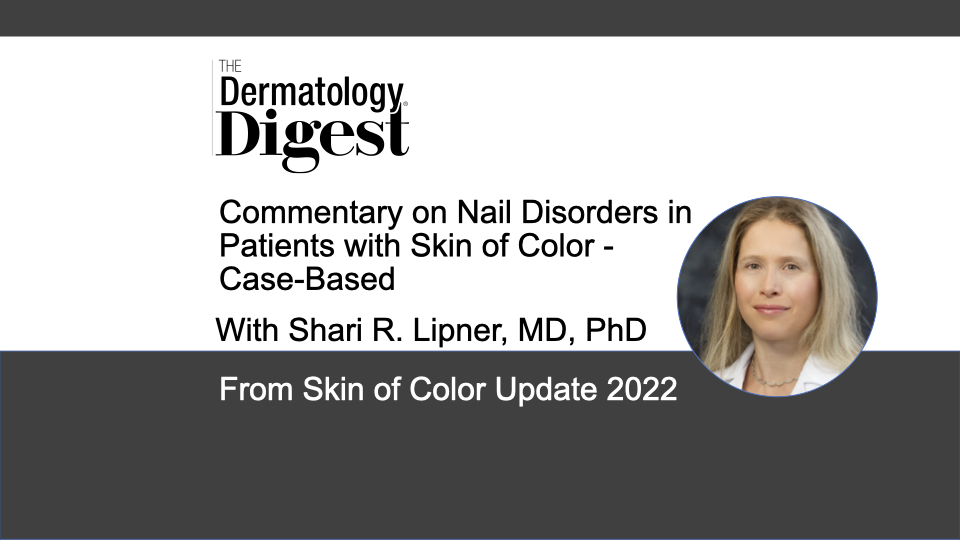Dr. Shari Lipner discusses longitudinal melanonychia in skin of color patients and how to potentially differentiate nonmelanocytic from melanocytic causes.
Shari R. Lipner, MD, PhD, Associate Professor of Clinical Dermatology and Director of the Nail Unit, Weill Cornell Medicine, New York, New York
“Longitudinal melanonychia is very common in patients with skin of color. The real challenge is to distinguish between nonmelanocytic and melanocytic causes of melanonychia. Nonmelanocytic etiologies include hematomas, bacterial infections, such as Pseudomonas aeruginosa, fungal melanonychia, as well as exogenous pigment,” said Shari Lipner, MD, PhD, who addressed longitudinal melanonychia during her presentation “Nail Disorders in Patients with Skin of Color – Case-Based” in this year’s Skin of Color Update meeting in New York, New York.
Dermatologists should think about melanocytic activation versus nail unit melanomas as melanocytic etiologies of longitudinal melanonychia in adults, according to Dr. Lipner.
“For melanocytic activation, there are many causes. Physiologic causes are very common in patients with darker skin types and may also occur during pregnancy. Melanocytic activation is also a common presentation in skin of color patients with inflammatory nail disorders, like lichen planus.”
Nail Unit Melanoma
“For melanocytic malignant causes, we worry, of course, about nail unit melanomas.”
Among the concerning signs for nail unit melanoma is the digit involved, according to Dr. Lipner.
“A single digit, particularly the thumb is of concern.”
Other concerning features include a band that is black and 3 mm or greater in width, splitting of the nail plate, bleeding, or pain, she said.
“But these are not very reliable markers for nail unit melanoma.”
For band width specifically, research has shown that patients with nail unit melanoma had about double the band width percentage compared to benign longitudinal melanonychia, said Dr. Lipner.
“In a study in the [Journal of the American Academy of Dermatology] JAAD that we published two years ago, we looked at band width percentage in consecutive patients at our institution who underwent a nail matrix biopsy for longitudinal melanonychia and found that patients with nail unit melanoma versus benign longitudinal melanonychia had about double the band width percentage. By band width percentage, I mean measuring the band width as well as the width of the entire nail.”1
The study’s authors were also interested in the presentation of benign longitudinal melanonychia in darker versus lighter skin patients, according to Dr. Lipner.
“In a recent JAAD study looking at clinical features of benign longitudinal in darker versus lighter skinned patients, we found that in darker skin patients bands were significantly darker and wider. And darker skin patients received more nail biopsies than lighter skin patients.”2
There is a need for a multi-center study to determine the criteria for biopsy in patients of all skin types, so that patients with benign melanonychia are spared nail matrix biopsies and patients with nail unit melanomas are diagnosed quickly and receive effective treatment, said Dr. Lipner.
Disclosure: Dr. Lipner reports no relevant disclosures.
References:
- Ko D, Oromendia C, Scher R, Lipner SR. Retrospective single-center study evaluating clinical and dermoscopic features of longitudinal melanonychia, ABCDEF criteria, and risk of malignancy. J Am Acad Dermatol. 2019 May;80(5):1272-1283. doi: 10.1016/j.jaad.2018.08.033. Epub 2019 Feb 11. Erratum in: J Am Acad Dermatol. 2020 Jan;82(1):260. PMID: 30765143.
- Lee DK, Chang MJ, Desai AD, Lipner SR. Clinical and dermoscopic findings of benign longitudinal melanonychia due to melanocytic activation differ by skin type and predict likelihood of nail matrix biopsy. J Am Acad Dermatol. 2022 Oct;87(4):792-799. doi: 10.1016/j.jaad.2022.06.1165. Epub 2022 Jun 22. PMID: 35752275.

